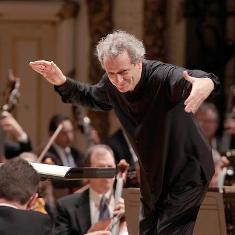
"Louis' Listening Party" a Hit
What does
music tell us?

And how does it do it?
Louis Langrée explored those questions Sunday afternoon at Music Hall at “Louis’ Listening Party,” a first-ever initiative by music director Langrée and the Cincinnati Symphony Orchestra to introduce the audience to the process of making music.
It was the culmination of the CSO’s 2014 “One City, One Symphony” project (also a Langrée initiative, begun in 2012) whereby listeners are prepared for a special concert through a series of neighborhood “listening parties,” hosted by CSO musicians and staff.
Centerpiece of this year’s concert was the Symphony No. 1 by Gustav Mahler, performed at CSO concerts Friday, Saturday and Sunday at Music Hall. On the first half of Sunday’s concert, Langrée provided a verbal introduction to the Symphony and led the CSO in musical examples. A complete performance of the work followed intermission.
It was a wholly engaging, as well as enlightening experience.
As it turned out, Mahler’s First Symphony made an ideal subject for such a project, with its path-breaking mix of classical and popular elements and with symphonic techniques susceptible to clear analysis. A delightful example of the latter was Mahler’s use of canon (strict imitative counterpoint). To instruct the audience, Langrée had them sing a round to Frère Jacques," which Mahler darkens and adapts in the Symphony's third movement.
The first bars of the Symphony made a perfect beginning for Langrée’s narrative. “What are they doing?” he asked as the CSO strings sounded their soft opening A’s. (It just happens that an orchestra tunes to this pitch.) Mahler, he explained was crafting a spell here, telling the listener that “something will happen.”
He went on to outline the first theme, beginning with the interval of a downward fourth, which is integral to the entire Symphony. He then showed how the first movement moves from “darkness to light,” or the coming of spring. During his analysis, he pointed out recurrences of the interval of a fourth throughout the Symphony.
Mahler is “under full sail” in the second movement, said Langrée, demonstrating its arch-like, ABA form, i.e. an extroverted first section followed by a more intimate one, then the return of the first. The two sections contrast in feeling, but are united by structure, he said: “Feeling and structure makes art.”
Langrée demonstrated how Mahler used “Fr ère Jacques” in the third movement -- a parody of a funeral march -- by casting it in a minor key and slowing it down. Principal bassist Owen Lee and principal bassoonist William Winstead sounded the opening bars to illustrate the canon
It was in the third movement that Langrée noted how revolutionary Mahler was for his day by inserting episodes of Klezmer and German band music into the Symphony. This shocked the critics, he said, who considered it a sacrilege (but became an example for subsequent composers).
Langrée called the final movement “from hell to paradise,” with its turbulent beginning – compare the images of Hieronymous Bosch, he added – and its emergence “into full sunshine” at the end.
After this entertaining explication, the performance of the complete Symphony – a brilliant one in full accord with the weekend’s earlier performances -- had much more meaning for its listeners, who awarded both conductor and orchestra a prolonged, enthusiastic ovation.
With “One City, One Symphony” and “Louis’ Listening Party,” a very productive tradition has begun for the CSO. Langrée deserves multiple bravi for bringing this new way to inform and engage the audience to fruition.